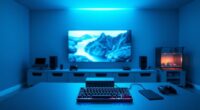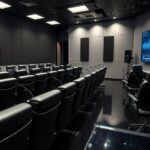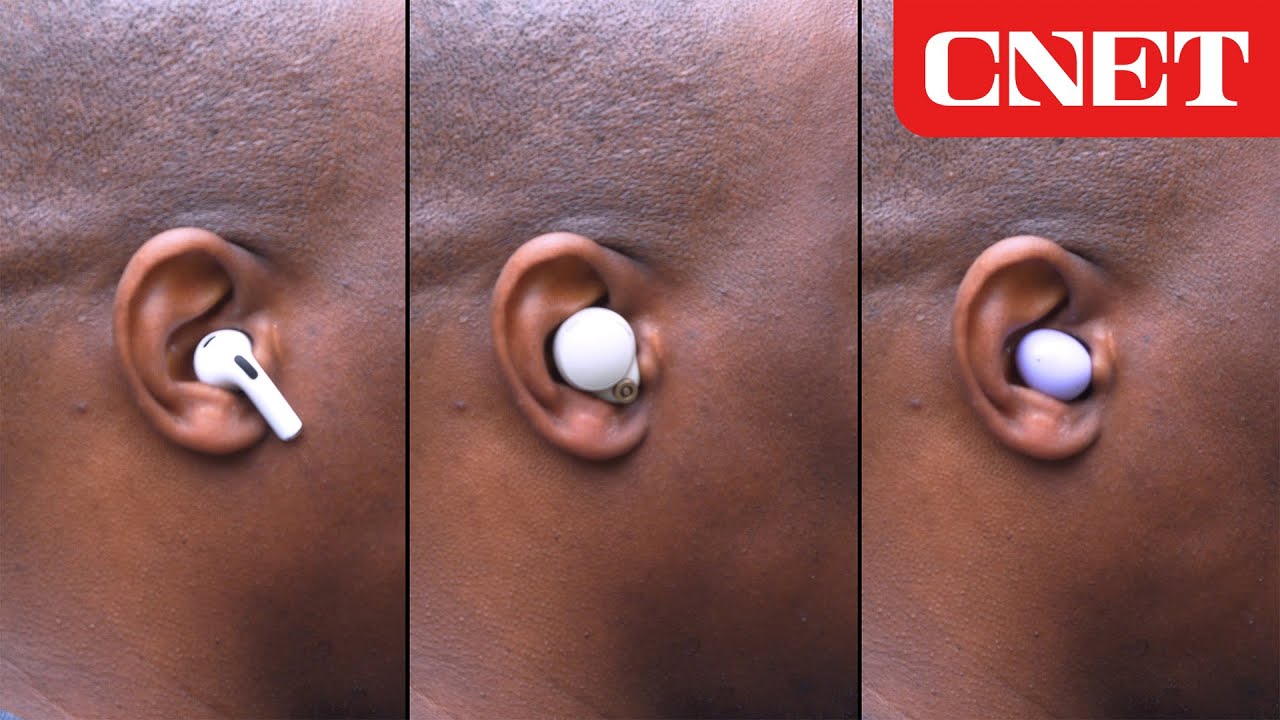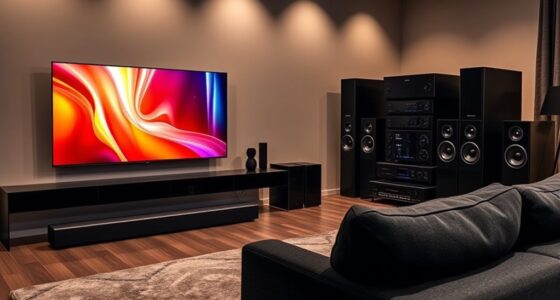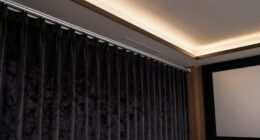Understanding calibration is key to getting the best audio and video quality from your system. It involves fine-tuning settings to match your room’s acoustics and layout, which helps eliminate issues like echoes, muffled sound, or uneven brightness. Proper calibration ensures your speakers are placed correctly, the sound is balanced, and the picture is clear. Keep going to learn how calibration can turn your setup into a high-fidelity experience tailored just for your space.
Key Takeaways
- Calibration ensures measurement accuracy, aligning audio and video outputs with optimal performance standards.
- Proper speaker placement and room adjustments prevent sound issues like echoes and uneven distribution.
- Calibration tools identify and correct acoustic anomalies, improving clarity and overall sound quality.
- It fine-tunes settings to match room characteristics, enhancing natural sound and visual synchronization.
- Overall, calibration maximizes equipment potential, delivering balanced, high-fidelity audio and clear video experiences.

Have you ever wondered how scientists and engineers guarantee their measurements are accurate? When it comes to audio and video systems, calibration plays a vital role in ensuring you experience the best quality possible. Proper calibration isn’t just about adjusting settings; it involves precise measurements and fine-tuning to match the environment and equipment. One of the key factors in achieving optimal sound quality is speaker placement. If your speakers aren’t positioned correctly, you might notice uneven sound distribution, echoes, or muffled audio. Calibration helps you identify the ideal placement by analyzing how sound travels within your space. This process considers room acoustics—how the shape, materials, and furnishings of your room influence sound waves. For example, hard surfaces like glass or tile reflect sound, creating echoes, while soft furnishings absorb sound, reducing clarity. Understanding these room acoustics allows you to adjust speaker placement strategically, minimizing issues like standing waves or null points where sound cancels out. When you calibrate your system, you might use tools such as sound level meters or calibration microphones to measure how sound propagates in your room. These measurements help you determine if speakers are too close to walls or placed at incorrect heights, which can distort audio quality. Proper speaker placement, guided by calibration, ensures the sound reaches your ears evenly and naturally. It also improves the overall listening experience by balancing bass, midrange, and treble frequencies, so you don’t have to strain to understand dialogue or enjoy rich music. Calibration also accounts for room acoustics—adjusting equalization settings to compensate for acoustic anomalies. For instance, if your room amplifies bass too much, calibration can reduce that frequency to prevent muddiness. Conversely, if treble sounds dull, calibration can boost high frequencies for clarity. This tailored approach guarantees that your audio sounds as close to the original recording as possible, regardless of room imperfections. When video is involved, calibration ensures your display is aligned with your audio setup, providing a synchronized and immersive experience. You can’t just rely on factory settings or guesswork; precise calibration considers all variables, including speaker placement and room acoustics, to enhance performance. Proper calibration also involves accurate measurements that help you fine-tune your system effectively. Ultimately, calibration becomes an essential step in transforming a basic setup into a high-fidelity system. It empowers you to make informed adjustments, reducing distortions and uneven sound, so you enjoy a richer, more accurate audio-visual experience. By paying attention to details like speaker placement and understanding room acoustics, you unlock the full potential of your equipment and get closer to the pristine sound and picture you deserve.
Frequently Asked Questions
How Often Should I Calibrate My Audio and Video Equipment?
You should calibrate your audio and video equipment every six months or after any significant settings adjustments or equipment updates. Regular calibration ensures peak performance, maintaining accurate colors and sound quality. If you notice inconsistencies or performance issues, it’s a good idea to recalibrate sooner. Keeping your calibration routine consistent helps preserve the quality of your entertainment experience, making sure your settings adjustments stay precise over time.
Can Calibration Fix All Audio and Video Issues?
Calibration can’t fix all audio and video issues, but it markedly improves performance when equipment compatibility is ideal. Using proper calibration techniques helps you fine-tune your devices for the best quality. If problems persist, check for compatibility issues or hardware faults. Regular calibration ensures your system stays aligned, but some issues may require troubleshooting beyond calibration, like updating firmware or replacing faulty components.
Do Professional Calibration Services Guarantee Better Sound and Picture?
Yes, professional calibration services generally guarantee better sound and picture because they guarantee calibration accuracy through expert techniques. When you hire professionals, you benefit from their specialized expertise, which fine-tunes your audio and video setup precisely. This results in a more immersive experience, with clearer images and richer sound. While calibration isn’t a fix-all, professional calibration markedly enhances your system’s performance, making your entertainment much more enjoyable.
Is Calibration Necessary for Everyday Viewing or Listening?
Calibration isn’t necessary for everyday viewing or listening, but it considerably enhances visual accuracy and sound quality. You’ll notice sharper images and more accurate colors, making your experience more immersive. Plus, proper calibration can extend your equipment’s longevity by reducing strain on components. While not essential daily, investing in calibration occasionally keeps your devices performing at their best, ensuring you enjoy the best possible audio and video quality over time.
What Are the Cost Differences Between DIY and Professional Calibration?
Sure, DIY calibration saves money, but your budget considerations might be better spent on new equipment that’s more compatible. Professional calibration costs more upfront, typically $200–$500, but it ensures peak performance and avoids costly mistakes. If you’re confident and tech-savvy, DIY might do, but if you want perfect audio and video, investing in professional calibration guarantees you won’t end up with a pixelated or off-tune mess.
Conclusion
Now that you know how calibration enhances your audio and video experience, aren’t you eager to give it a try? Proper calibration ensures you’re seeing and hearing content as it’s meant to be, making every moment more immersive. Don’t settle for subpar quality—take a few minutes to calibrate your devices and enjoy the true potential of your entertainment setup. After all, isn’t it worth experiencing content exactly how creators intended?

